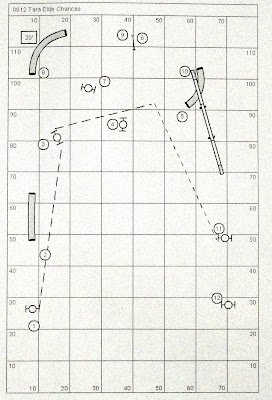1. a condition in which peripheral vision is greatly restricted
2. narrowness of viewpoint resulting from concentration on a single idea, opinion, etc, to the exclusion of others
 Although the Q rate in Elite and Open on this Chances course was close to 50%, Belle and I were not among those teams who Q'ed because we feel victim to tunnel vision. There are two meanings of the term "tunnel vision," and our run fell victim to both.
Although the Q rate in Elite and Open on this Chances course was close to 50%, Belle and I were not among those teams who Q'ed because we feel victim to tunnel vision. There are two meanings of the term "tunnel vision," and our run fell victim to both.The tunnel in the upper left corner is about 35' away from the exit of the first tunnel, and it never occurred to me that it was a viable off-course. I was focused on the turn to the #3 hoop, and I really thought was it was a given since I practically lead out to it. I felt really bad for blaming Belle for failing to see the obvious, when it was I who had failed to see. Thanks to Cynthia Ernat for pointing out to me how well the corner tunnel lined up with the start line.
 Normally, I would have called Belle as she exited the tunnel. (I know, I know, I should actually call her when she's in the tunnel, but my reflexes suck.) However, in light of how many verbal mistakes I made yesterday, I had resolved to use as few verbals as possible today. This, unfortunately, was a spot that screamed for a verbal cue.
Normally, I would have called Belle as she exited the tunnel. (I know, I know, I should actually call her when she's in the tunnel, but my reflexes suck.) However, in light of how many verbal mistakes I made yesterday, I had resolved to use as few verbals as possible today. This, unfortunately, was a spot that screamed for a verbal cue. As the dog sits at the start line waiting to be released, if he is looking straight ahead, he sees is the tunnel in the corner looming large and invitingly--especially since today, Chances followed Tunnelers. Even for those dogs with no start line stay, the vision from within the first tunnel was most certainly "tunnel vision."
The other two "traps" on this course were obvious: the dog has to turn from jump #6 to hoop #7, and then there is a dog walk/tunnel discrimination. Unlike the problems we all encountered yesterday getting our dogs to carry out to a hoop after the tunnel, most of the dogs came out of the tunnel and took the jump. Unfortunately, a fair number of them continued on to the off-course tunnel. (This turn away from the tunnel was also tested on both Regular courses, so you had a chance to redeem yourself.)
When we were walking the course, I happened to overhear Cynthia Ernat discussing handling the line from #5 to #6: Instead of turning the dog immediately as he exits the tunnel, it would be better to let him run out ten feet or more before turning indicating the turn. Turning sharply to #6 puts the dog on a path to the off-course tunnel. Allowing your dog to run out from the tunnel first, results in him heading more toward the #7 hoop as he takes the jump.
Chance Statistics
Elite 7 Q's/18 runs
Open 4 Q's/9 runs
Novice 1 Q/13 runs

No comments:
Post a Comment